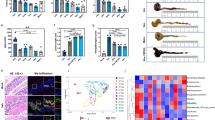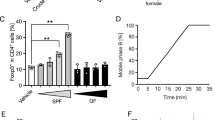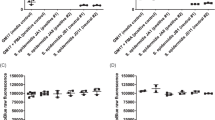Abstract
Small molecules derived from symbiotic microbiota critically contribute to intestinal immune maturation and regulation1. However, little is known about the molecular mechanisms that control immune development in the host–microbiota environment. Here, using a targeted lipidomic analysis and synthetic approach, we carried out a multifaceted investigation of immunomodulatory α-galactosylceramides from the human symbiont Bacteroides fragilis (BfaGCs). The characteristic terminal branching of BfaGCs is the result of incorporation of branched-chain amino acids taken up in the host gut by B. fragilis. A B. fragilis knockout strain that cannot metabolize branched-chain amino acids showed reduced branching in BfaGCs, and mice monocolonized with this mutant strain had impaired colonic natural killer T (NKT) cell regulation, implying structure-specific immunomodulatory activity. The sphinganine chain branching of BfaGCs is a critical determinant of NKT cell activation, which induces specific immunomodulatory gene expression signatures and effector functions. Co-crystal structure and affinity analyses of CD1d–BfaGC–NKT cell receptor complexes confirmed the interaction of BfaGCs as CD1d-restricted ligands. We present a structural and molecular-level paradigm of immunomodulatory control by interactions of endobiotic metabolites with diet, microbiota and the immune system.
This is a preview of subscription content, access via your institution
Access options
Access Nature and 54 other Nature Portfolio journals
Get Nature+, our best-value online-access subscription
$29.99 / 30 days
cancel any time
Subscribe to this journal
Receive 51 print issues and online access
$199.00 per year
only $3.90 per issue
Buy this article
- Purchase on Springer Link
- Instant access to full article PDF
Prices may be subject to local taxes which are calculated during checkout




Similar content being viewed by others
Data availability
Raw data for NKT cell transcriptomic analysis was deposited in the NCBI Sequence Read Archive (SRA) with accession PRJNA750126. The crystal structures of the 2C12 TCR–mCD1d–SB2217 and 2C12 TCR–mCD1d–SB2219 ternary complexes were deposited in the Protein Data Bank under accession numbers 7M72 and 6XNG, respectively. Lipidomic analysis data containing MS1 scans were deposited to Metabolomics Workbench study number ST001910.
Change history
09 January 2022
A Correction to this paper has been published: https://doi.org/10.1038/s41586-021-04276-7
References
Surana, N. K. & Kasper, D. L. Deciphering the tête-à-tête between the microbiota and the immune system. J. Clin. Invest. 124, 4197–4203 (2014).
Skelly, A. N., Sato, Y., Kearney, S. & Honda, K. Mining the microbiota for microbial and metabolite-based immunotherapies. Nat. Rev. Immunol. 19, 305–323 (2019).
Surana, N. K. & Kasper, D. L. The yin yang of bacterial polysaccharides: lessons learned from B. fragilis PSA. Immunol. Rev. 245, 13–26 (2012).
Erturk-Hasdemir, D. et al. Symbionts exploit complex signaling to educate the immune system. Proc. Natl Acad. Sci. USA 116, 26157–26166 (2019).
Vatanen, T. et al. Variation in microbiome LPS immunogenicity contributes to autoimmunity in humans. Cell 165, 842–853 (2016).
d’Hennezel, E., Abubucker, S., Murphy, L. O. & Cullen, T. W. Total lipopolysaccharide from the human gut microbiome silences Toll-like receptor signaling. mSystems 2, (2017).
Kawahara, K., Tsukano, H., Watanabe, H., Lindner, B. & Matsuura, M. Modification of the structure and activity of lipid A in Yersinia pestis lipopolysaccharide by growth temperature. Infect. Immun. 70, 4092–4098 (2002).
Erturk-Hasdemir, D. & Kasper, D. L. Finding a needle in a haystack: Bacteroides fragilis polysaccharide a as the archetypical symbiosis factor. Ann. NY Acad. Sci. 1417, 116–129 (2018).
Wieland Brown, L. C. et al. Production of α-galactosylceramide by a prominent member of the human gut microbiota. PLoS Biol. 11, e1001610 (2013).
An, D. et al. Sphingolipids from a symbiotic microbe regulate homeostasis of host intestinal natural killer T cells. Cell 156, 123–133 (2014).
Wingender, G. et al. Intestinal microbes affect phenotypes and functions of invariant natural killer T cells in mice. Gastroenterology 143, 418–428 (2012).
Kinjo, Y. et al. Recognition of bacterial glycosphingolipids by natural killer T cells. Nature 434, 520–525 (2005).
Brondz, I. & Olsen, I. Multivariate analyses of cellular fatty acids in Bacteroides, Prevotella, Porphyromonas, Wolinella, and Campylobacter spp. J. Clin. Microbiol. 29, 183–189 (1991).
Miyagawa, E., Azuma, R., Suto, T. & Yano, I. Occurrence of free ceramides in Bacteroides fragilis NCTC 9343. J. Biochem. 86, 311–320 (1979).
Leo, R. F. & Parker, P. L. Branched-chain fatty acids in sediments. Science 152, 649–650 (1966).
Naik, D. N. & Kaneda, T. Biosynthesis of branched long-chain fatty acids by species of Bacillus: relative activity of three alpha-keto acid substrates and factors affecting chain length. Can. J. Microbiol. 20, 1701–1708 (1974).
Beck, H. C. Branched-chain fatty acid biosynthesis in a branched-chain amino acid aminotransferase mutant of Staphylococcus carnosus. FEMS Microbiol. Lett. 243, 37–44 (2005).
Kaneda, T. Iso-and anteiso-fatty acids in bacteria: biosynthesis, function, and taxonomic significance. Microbiol. Rev. 55, 288–302 (1991).
Liberzon, A. et al. The Molecular Signatures Database Hallmark gene set collection. Cell Syst. 1, 417–425 (2015).
Pellicci, D. G. et al. Differential recognition of CD1d-α-galactosyl ceramide by the Vβ8.2 and Vβ7 semi-invariant NKT T cell receptors. Immunity 31, 47–59 (2009).
Girardi, E. & Zajonc, D. M. Molecular basis of lipid antigen presentation by CD1d and recognition by natural killer T cells. Immunol. Rev. 250, 167–179 (2012).
Rossjohn, J., Pellicci, D. G., Patel, O., Gapin, L. & Godfrey, D. I. Recognition of CD1d-restricted antigens by natural killer T cells. Nat. Rev. Immunol. 12, 845–857 (2012).
Chennamadhavuni, D. et al. Dual modifications of α-galactosylceramide synergize to promote activation of human invariant natural killer T cells and stimulate anti-tumor immunity. Cell Chem. Biol. 25, 571-584.e8 (2018).
Li, Y. et al. The Vα14 invariant natural killer T cell TCR forces microbial glycolipids and CD1d into a conserved binding mode. J. Exp. Med. 207, 2383–2393 (2010).
Wun, K. S. et al. A molecular basis for the exquisite CD1d-restricted antigen specificity and functional responses of natural killer T cells. Immunity 34, 327–339 (2011).
Natori, T., Koezuka, Y. & Higa, T. Agelasphins, novel α-galactosylceramides from the marine sponge Agelas mauritianus. Tetrahedron Lett. 34, 5591–5592 (1993).
Kobayashi, E. et al. Enhancing effects of agelasphin-11 on natural killer cell activities of normal and tumor-bearing mice. Biol. Pharm. Bull. 19, 350–353 (1996).
Kobayashi, E., Motoki, K., Uchida, T., Fukushima, H. & Koezuka, Y. KRN7000, a novel immunomodulator, and its antitumor activities. Oncol. Res. 7, 529–534 (1995).
Li, X. et al. Design of a potent CD1d-binding NKT cell ligand as a vaccine adjuvant. Proc. Natl Acad. Sci. USA 107, 13010–13015 (2010).
Laurent, X. et al. Switching invariant natural killer T (iNKT) cell response from anticancerous to anti-inflammatory effect: molecular bases. J. Med. Chem. 57, 5489–5508 (2014).
Sag, D., Krause, P., Hedrick, C. C., Kronenberg, M. & Wingender, G. IL-10–producing NKT10 cells are a distinct regulatory invariant NKT cell subset. J. Clin. Invest. 124, 3725–3740 (2014).
Olszak, T. et al. Protective mucosal immunity mediated by epithelial CD1d and IL-10. Nature 509, 497–502 (2014).
Brutkiewicz, R. R. CD1d ligands: the good, the bad, and the ugly. J. Immunol. 177, 769–775 (2006).
Joyce, S., Girardi, E. & Zajonc, D. M. NKT cell ligand recognition logic: molecular basis for a synaptic duet and transmission of inflammatory effectors. J. Immunol. 187, 1081–1089 (2011).
Chung, H. et al. Gut immune maturation depends on colonization with a host-specific microbiota. Cell 149, 1578–1593 (2012).
Stewart, C. J. et al. Temporal development of the gut microbiome in early childhood from the TEDDY study. Nature 562, 583–588 (2018).
Sefik, E. et al. Individual intestinal symbionts induce a distinct population of ROR+ regulatory T cells. Science 349, 993–997 (2015).
Varel, V. H. & Bryant, M. P. Nutritional features of Bacteroides fragilis subsp. fragilis. Appl. Microbiol. 28, 251–257 (1974).
Matyash, V., Liebisch, G., Kurzchalia, T. V., Shevchenko, A. & Schwudke, D. Lipid extraction by methyl- tert -butyl ether for high-throughput lipidomics. J. Lipid Res. 49, 1137–1146 (2008).
Comstock, L. E. et al. Analysis of a capsular polysaccharide biosynthesis locus of Bacteroides fragilis. Infect. Immun. 67, 3525–3532 (1999).
Lim, B., Zimmermann, M., Barry, N. A. & Goodman, A. L. Engineered regulatory systems modulate gene expression of human commensals in the gut. Cell 169, 547–558.e15 (2017).
Olszak, T. et al. Microbial exposure during early life has persistent effects on natural killer T cell function. Science 336, 489–493 (2012).
Dobin, A. et al. STAR: ultrafast universal RNA-seq aligner. Bioinformatics 29, 15–21 (2013).
Liao, Y., Smyth, G. K. & Shi, W. featureCounts: an efficient general purpose program for assigning sequence reads to genomic features. Bioinformatics 30, 923–930 (2014).
Love, M. I., Huber, W. & Anders, S. Moderated estimation of fold change and dispersion for RNA-seq data with DESeq2. Genome Biol. 15, 550 (2014).
Wickham, H. ggplot2: elegant graphics for data analysis. https://ggplot2.tidyverse.org/ (accessed: 9 March 2021).
Korotkevich, G. et al. Fast gene set enrichment analysis. Preprint at https://doi.org/10.1101/060012 (2016).
Matsuda, J. L. et al. Tracking the response of natural killer T cells to a glycolipid antigen using CD1d tetramers. J. Exp. Med. 192, 741–754 (2000).
Kabsch, W. XDS. Acta Crystallogr. D 66, 125–132 (2010).
Evans, P. Scaling and assessment of data quality. Acta Crystallogr. D 62, 72–82 (2006).
Adams, P. D. et al. PHENIX: A comprehensive Python-based system for macromolecular structure solution. Acta Crystallogr. D 66, 213–221 (2010).
Emsley, P., Lohkamp, B., Scott, W. G. & Cowtan, K. Features and development of Coot. Acta Crystallogr. D 66, 486–501 (2010).
Bricogne G. et al. BUSTER Version 2.10.3 (Global Phasing Ltd, 2017).
Tong, J., Liu, C., Summanen, P., Xu, H., Finegold, S. M. Application of quantitative real-time PCR for rapid identification of Bacteroides fragilis group and related organisms in human wound samples. Anaerobe 17, 64–68 (2011).
Suzuki, M. T., Taylor, L. T. & DeLong, E. F. Quantitative analysis of small-subunit rRNA genes in mixed microbial populations via 5′-nuclease assays. Appl. Environ. Microbiol. 66, 4605–4614 (2000).
Acknowledgements
We thank J. McCoy and E. J. Paik for manuscript preparation, R. T. Bronson for histopathological scoring, S. Iyer, L. Gebremedhin, E. Choi and T. Yanostang for technical assistance, and the staff at the Australian Synchrotron for assistance with data collection. This work was supported by National Institutes of Health (K01-DK102771 and R01-AT010268 to S.F.O., and R01-DK044319 to R.S.B.), Department of Defense (W81XWH-19-1-0625 to D.L.K.), Brigham and Women’s Hospital (Department of Anesthesiology, Perioperative and Pain Medicine Basic Science Grant to S.F.O.), the National Research Foundation of Korea (2014R1A3A2030423 and 2012M3A9C4048780 to S.B.P.), and the Australian Research Council (ARC) (CE140100011 and ARC Laureate Fellowship to J.R., and ARC Future Fellowship to J.L.N.). Graphical images used for the Fig. 2 were created with BioRender.com.
Author information
Authors and Affiliations
Contributions
S.F.O., D.L.K. and R.S.B. conceived the idea and designed the outline of the research. S.F.O., H.B.S. and S.B.P. designed the structures of synthetic BfaGCs; H.B.S., Y.S.H., H.K. and J.L. synthesized BfaGC molecules. T.P., J.L.N. and J.R. generated crystals of 2C12 TCR–CD1d–BfaGCs and carried out X-ray crystallography analysis as well as affinity measurements by SPR. S.F.O., J.-S.Y. and C.C.L. designed and carried out all experiments with microorganisms. S.F.O., D.-J.J. and D.E.-H. executed in vitro and in vivo cytokine assays. S.F.O. and D.-J.J. designed and carried out all animal experiments. J.-S.Y. carried out transcriptomic analysis. S.F.O., S.B.P., J.R. and D.L.K. wrote the manuscript, and all authors contributed to relevant discussions.
Corresponding authors
Ethics declarations
Competing interests
S.F.O., R.S.B. and D.L.K. have filed a patent on the functions of BfaGCs and related structures (US patent 10,329,315). S.F.O., S.B.P. and D.L.K. filed a patent on the functions of BfaGCs and related structures (under review).
Additional information
Peer review information Nature thanks the anonymous reviewer(s) for their contribution to the peer review of this work.
Publisher’s note Springer Nature remains neutral with regard to jurisdictional claims in published maps and institutional affiliations.
Extended data figures and tables
Extended Data Fig. 2 LC-MS profile of BfaGCs.
(A) Representative extracted ion chromatograms (XICs) of C32–C36 BfaGCs. (B) C34 BfaGCs are the major component of B. fragilis glycosphingolipids (N=5).
Extended Data Fig. 3 LC-MS/MS assignment of C34 BfaGC structural variants.
(A) The MS/MS-XIC of total C34 BfaGCs (762→698) shows that BfaGCs are isobaric mixtures separated by RP-HPLC. (B, C) MS/MS-XICs of C34 BfaGCs reveal co-eluting chemical homologues. Two isobaric species with aliphatic chains of C17/C17 (B) and C18/C16 (C) were assigned MS/MS fingerprints of 490 and 504, respectively. (D) MS/MS fingerprints of three peaks show a distinct difference in relative intensity between MS/MS fragments of 490 (C17/C17) and 504 (C18/C16), implying that the latter two peaks are a mixture of chain-length homologues. Chromatograms and spectra represent triplicate observations. (E-H) MS/MS spectra of the most abundant peaks of (E) C32, (F) C33, (G) C35 and (H) C36 BfaGCs. MS/MS fingerprint of 462–518 indicates lengths of sphinganine and acyl chains. Spectra are representative of triplicate observation.
Extended Data Fig. 4 Chemical structures of 23 synthetic BfaGCs.
(SB2201–SB2223).
Extended Data Fig. 5 BCAA dictates branching of BfaGCs by direct incorporation in vivo.
(A–E) Ratios among differently branched C34 BfaGCs (MS1 XIC=762.57, as [M+HCOO-]) are clearly different for B. fragilis grown in rich medium (A) and B. fragilis grown in minimal medium (B). Supplementation with individual BCAAs (C–E) on defined medium increases production of branched-chain (both dibranched and monobranched) BfaGCs. (F–H) MS/MS fingerprints confirm the incorporation of leucine and isoleucine into the C17/C17 ceramide backbone (via C5 branched acyl-CoA) and of valine into the C18/C16 backbone (via C4 branched acyl-CoA). Chromatograms and spectra are representative of triplicate observations. (I) An MS/MS-XIC of d3- and d6-C34 BfaGC shows that deuterium-labeled leucine is actively incorporated into BfaGC. (J-K) MS/MS pattern shows distinctive differences between gut luminal BfaGC (M+3 isotopolog) in (J) presence or (K) absence of d3-leucine, showing MS2 fragments in presence of d3-leucine reflect inclusion of deuterium-labeled leucine in the structure. Chromatograms and spectra are representative results of four mice.
Extended Data Fig. 6 Genetic study of B. fragilis Bcat orthologue (BF9343-3671).
(A) Confirmation of the target gene deletion by PCR. (B) The knockout strain (BF9343-Δ3671) shows comparable growth pattern to isogenic WT strain (grown in duplicate per group), and a complemented strain of KO strain with empty vector shows same pattern to BF9343-3671 complemented strain. (C) BF9343-Δ3671 complementation can recover the production of di-branched C17/C17 BfaGC production to wild-type level. (D) WT and mutant strain (N=5 for each group) can colonize mouse in comparable density. All results represent of two independent experiments with similar trend. For gel source data, see Supplementary Fig. 1.
Extended Data Fig. 7 Structure-specific actions of BfaGCs.
(A) NKT cell–APC co-culture assays show that branching of sphinganine chain is, but 3’-OH group is not, critical for IL-2 inducing activity. Results are shown in duplicate and represent three independent experiment sets with similar trend (p=0.017 for 100nM and p=0.026 for 1000nM). (B-C) When injected intraperitoneally (N=5 per group, one sample in OCH group in panel C was lost), unlike Th1- or Th2-skewed prototypic ligands such as KRN7000 or OCH, SB2217 only weakly induce IFN-γ and did not induce IL-4 in vivo. (D-F) SB2217 weakly induced expression of co-stimulatory molecules such as CD86, CD40 and CD80 in splenic DCs, where SB2219 did not (N=5 per group).
Extended Data Fig. 8 Transcriptomic landscape of splenic NKT cells in responses to agonists.
(A) A heatmap shown with the Euclidean distances between different treatment groups. (B) Transcriptomic profile comparison of SB2217, SB2219 and OCH. (C) Pathway enrichment analysis of SB2217 reveals increased expression of immunoregulatory pathways in NKT cells when compared to vehicle or SB2219.
Extended Data Fig. 9 Comparison between SB2217 and SB2219 in mCD1d-BfaGC-2C12 complexes.
(A) 2Fo-Fc electron density map (in blue) contoured at a 0.8σ level of the BfaGCs within each ternary complex. (B) Fo-Fc electron density map (in brown) contoured at a 2.2σ level of the BfaGCs and spacer lipids within each ternary complex. SB2217 is shown as blue and SB2219 is shown as green; Spacer lipids are shown as black sticks. (C) Superimposition of the headgroups of BfaGCs and KRN7000 (PDB code: 6BNK). (D) 2C12 TCR molecular interactions with SB2217 (in blue). mCD1d and CDR loops are colored as in Fig. 4a. Hydrogen bonds are shown as red dashed lines. (E-F) The mCD1d–SB2217 complex shows higher affinity to 2C12 TCR than the mCD1d–SB2219 complex. (E) Each SPR datapoint is mean of techincal duplicate and KD values (mean±SD) were calculated from two independent results, using a single-site binding model with KD as a shared variable. (F) The sensorgrams are results of single experiment.
Extended Data Fig. 10 BfaGC profile in human microbiota-associated mice.
(A) BfaGC and B. fragilis abundance shows positive correlation in B. fragilis-gavaged HMB mice. Results are from longitudinally collected samples (2, 3 and 7 days after B. fragilis oral introduction) from five mice (total N=15). (B) BfaGC (C17/C17 dibranched and monobranched) are identified from neonatal (p14) GI contents. Chromatogram and spectrum represent seven samples.
Supplementary information
Supplementary Information
This file contains Supplementary Tables; Supplementary Figs. 1 (raw gel data) and 2 (FACS gating strategies for immune cell analysis); raw data (weight monitoring over disease time course) of in vivo experiment (oxazolone colitis); and total organic synthesis of BfaGC analogue (SB2201‐SB2223) library.
Rights and permissions
About this article
Cite this article
Oh, S.F., Praveena, T., Song, H. et al. Host immunomodulatory lipids created by symbionts from dietary amino acids. Nature 600, 302–307 (2021). https://doi.org/10.1038/s41586-021-04083-0
Received:
Accepted:
Published:
Issue Date:
DOI: https://doi.org/10.1038/s41586-021-04083-0
This article is cited by
-
CD1-mediated immune responses in mucosal tissues: molecular mechanisms underlying lipid antigen presentation system
Experimental & Molecular Medicine (2023)
-
Unconventional immune cells in the gut mucosal barrier: regulation by symbiotic microbiota
Experimental & Molecular Medicine (2023)
-
Microbiota-dependent regulation of costimulatory and coinhibitory pathways via innate immune sensors and implications for immunotherapy
Experimental & Molecular Medicine (2023)
-
Gut microbiota bridges dietary nutrients and host immunity
Science China Life Sciences (2023)
-
Contribution of the microbiome for better phenotyping of people living with obesity
Reviews in Endocrine and Metabolic Disorders (2023)
Comments
By submitting a comment you agree to abide by our Terms and Community Guidelines. If you find something abusive or that does not comply with our terms or guidelines please flag it as inappropriate.



